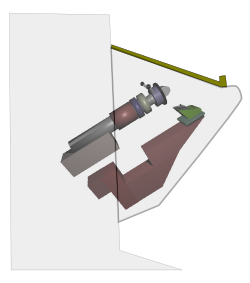Freezing is a fast way to get samples hardened without embedding. It has several advantages. a) Better molecular preservation, which is good for techniques requiring molecular detection. b) Frozen samples can be sectioned in thin sections (5 to 15 µm), but also in thicker sections of about hundreds of µm, and in thinner sections of about nm (ultrathin sections). c) Good quality sections can be obtained from a wide variety of tissues, excepting the mineralized tissues like bone, or highly keratinized tissues like horns. d) It may be the faster way of getting sections because unfixed material can be cut, such as biopsies. However, to preserve the tissular integrity, a very fast and deep freezing must be done to prevent ice crystals that destroy the tissue.
The two most commoon apparatuses for cutting frozen samples are the freezing microtome and the cryostate.
The freezing microtome (Figure 1) makes thick sections (dozens of µm in thickness). It consists of a deep cooled platform (about -20 ºC to -40 ºC) where the sample is placed and frozen. The platform is raised after each section a distance that correspond with the selected thickness. In old freezing microtomes, both the platform and the sample were frozen at the same time by using carbonic gas, which had to be applied regularly to keep the temperature of the sample low. The current freezing microtomes have a tube connecting an external cooling device with the platform. The tube contains a liquid that transfers the low temperature to the platform. It is also possible to cool the blade at the same temperature as the sample. The sample is frozen by physical contact with the cooled platform, and the temperature is almost constant during the sectioning period. Sections are collected from the blade with a little brush and transferred to the working buffer. They are free floating sections.

If the sample does not need to be cut immediately, tissues are fixed and then immersed in an antifreeze solution containing sucrose and glycerol. This solution prevents the formation of large ice crystals that damage the tissular structures. Ice crystal formation is also prevented with a fast and deep freezing, for example by liquid nitrogen. Cellular ultrastructure can be studied after antifreeze immersion and fast freezing. If the ultrastructure is not important, samples can be frozen at temperatures between -20 ºC and -80 ºC.
Crysotate (Figure 2) is used for obtaining 10 to 30 µm thick sections. All the sectioning process happens in a freezing chamber at -20 to -30 ºC (Figure 3). The sample is frozen in a cooler platform (about -50 ºC) located inside the chamber. Sample can be frozen by other means like liquid nitrogen, but it is recommendable to let the sample balances its temperature with the temperature of the chamber to get homogeneous good quality sections. Before freezing, the sample is immersed in a viscous liquid at room temperature that is solid at the lower temperature of the chamber. The sample is surrounded, but not infiltrated, by this liquid, so that we have a solid block with the sample inside. In this way, manipulation of the sample and get it fixed to a holder is easier. The holder is placed in a device that gets closer over the blade after each section is obtained. The mechanism is similar to that described for paraffin rotary microtome. Sections are first released upon the blade and then adhered to a slide by physical contact (Figure 4). Slides have been previously treated to have adhesive surfaces. Sections melt when they are contacted by the slide because slides come at room temperature. Then, the sections are dried at room temperature or in a refrigerator. Once they are dry, histological staining or processing can start.



There is a more sophisticated microtome called ultracryotome. It is able to cut ultrathin sections (dozens of nm in thickness) to be observed with the transmission electron microscopy. In this way, it is possible to study the ultrastructural features of tissues without embedding, and hence the molecular preservation is higher.
 Vibratome
Vibratome